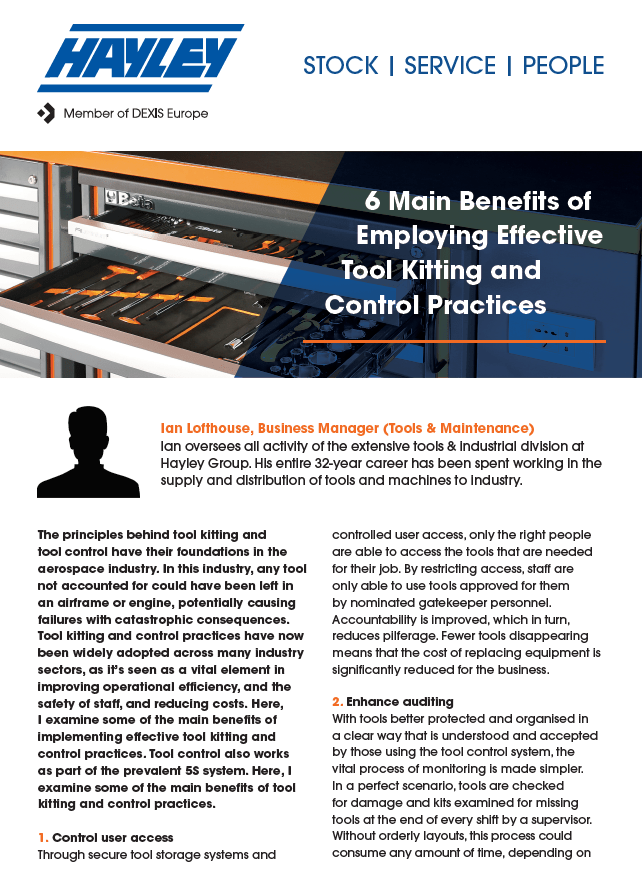By Ian Lofthouse, Business Manager (Tools & Maintenance)
Ian oversees all activity of the extensive tools & industrial division at Hayley Group. His entire 32-year career has been spent working in the supply and distribution of tools and machines to industry.
The principles behind tool kitting and tool control have their foundations in the aerospace industry. In this industry, any tool not accounted for could have been left in an airframe or engine, potentially causing failures with catastrophic consequences. Tool kitting and control practices have now been widely adopted across many industry sectors, as it’s seen as a vital element in improving operational efficiency, and the safety of staff, and reducing costs. Here, I examine some of the main benefits of implementing effective tool kitting and control practices. Tool control also works as part of the prevalent 5S system. Here, I examine some of the main benefits of tool kitting and control practices.
1. Control user access
Through secure tool storage systems and controlled user access, only the right people are able to access the tools that are needed for their job. By restricting access, staff are only able to use tools approved for them by nominated gatekeeper personnel. Accountability is improved, which in turn, reduces pilferage. Fewer tools disappearing means that the cost of replacing equipment is significantly reduced for the business.
2. Enhance auditing
With tools better protected and organised in a clear way that is understood and accepted by those using the tool control system, the vital process of monitoring is made simpler. In a perfect scenario, tools are checked for damage and kits examined for missing tools at the end of every shift by a supervisor. Without orderly layouts, this process could consume any amount of time, depending on the volume of tools required by the operation. Beta tool assortments are available in rigid thermoformed trays, ready for placement within their roller cabinets. Each tool can only fit into its designated space within the tray, making it easy to see which items have not been returned. As a result, monitoring and auditing are made more efficient and effective, with fewer absent items being missed.
3. Minimise downtime
Time taken searching for tools, whether they are lost or misplaced, is time wasted. This time should ideally be spent working on and progressing the tasks at hand. The same goes for if the location of tools is not fully optimised, and staff are forced to travel away from their immediate vicinity to collect tools. Solutions such as Beta roller cabinets enable tools to be available at the point of use, helping to reduce periods of non-productivity. Production is directly linked to revenue, so businesses need to do everything they can to cut back on any downtime. Implementing best practice in regards to tool kitting and control can have a really positive impact.
4. Improve tool selection
A key aim of tool control systems is to make the tool selection process easier. This can be done by various means starting with assigning every tool a unique place within the system – this makes monitoring and flagging missing items simpler too. Using colour to create clear visual clues, perhaps in the form of high viz foam inserts, or making it impossible to return a tool to anything other than its specified place by using solutions such as Beta thermoformed trays, are all ways which help improve selection. Beta tools can also be etched for identification. Users can complete visual checks quickly, and when a tool is required, users know where to find it.
5. Improve health & safety
By adopting tool kitting and tool control practices, the health and safety implications to staff using tools and equipment as part of your operation, are eased. Risks associated with cross contamination and shared tools are also minimised. With fewer tools being left unaccounted for in hazardous places, Foreign Object Debris (FOD) related breakdowns and injuries can become a thing of the past. And, with certain tools restricted to only trained staff, the risk of incidents caused by tool and equipment misuse is reduced further. This is important, as accidents have the capability of resulting in injury or even death of staff members, and can bring the risk of legal proceedings being levied against the business, resulting in a negative hit to reputation and ultimately, sales.
6. Reduce inventory
The final benefit to be gained from enhancing your tool control and kitting processes that I wanted to cover here is; a reduced inventory. Putting tool kitting and control practices in-place can help to reduce the total cost of ownership (TCO) involved in purchasing, maintaining and replacing your tools, equipment and consumables. A business having to cover the TCO for potentially several engineers, all with their own toolkits, will be spending considerably more money than a business with a single tool kit containing everything needed for the tasks at hand.
By working with an intelligent tool control system, businesses can get an insight into what tools are used and required, meaning that these are the items that are purchased and monitored for replacement. Tools that were previously purchased and used rarely, if ever, are no longer contributing to a large inventory and high TCO.
Hayley Group are partnered with Beta, a market-leading producer of professional working tools and instruments. We are therefore able to work with customers to both source and install the optimum tool kitting and control system solutions for them.



